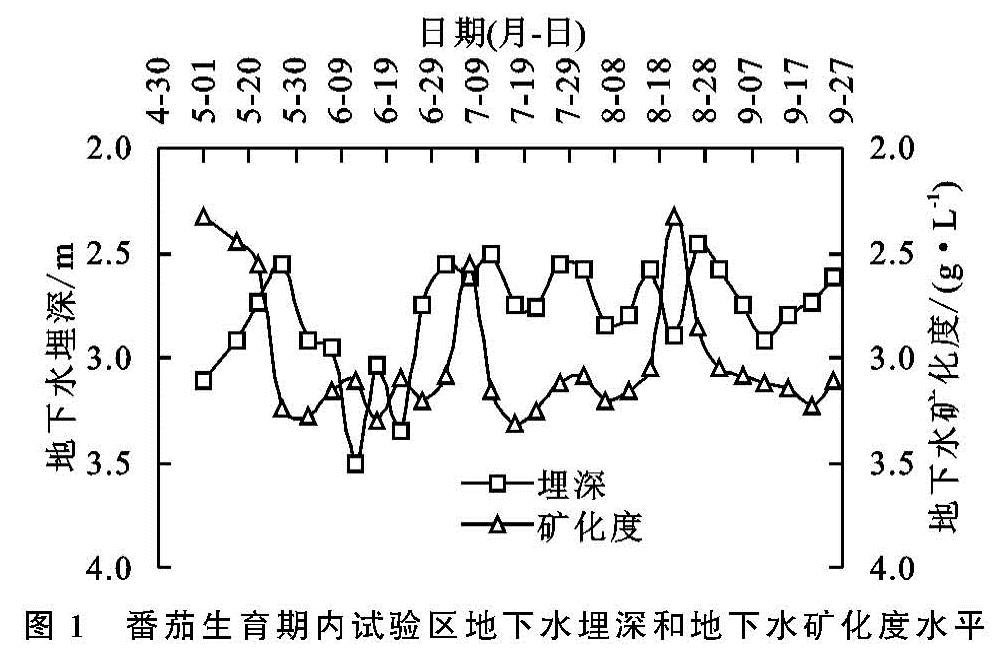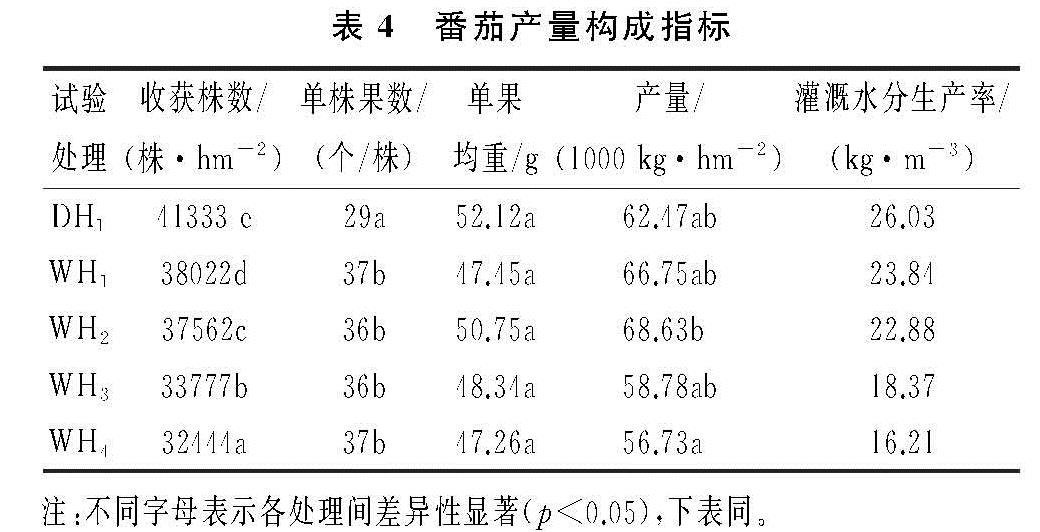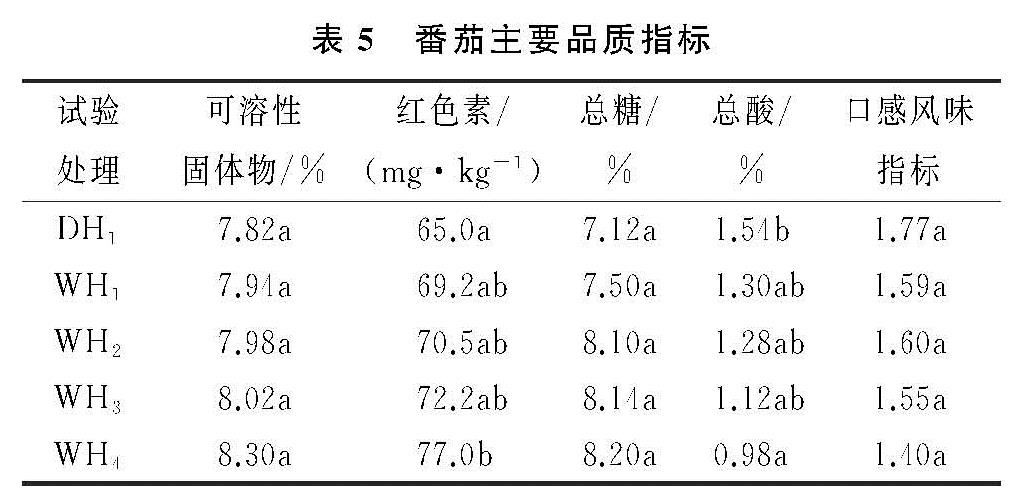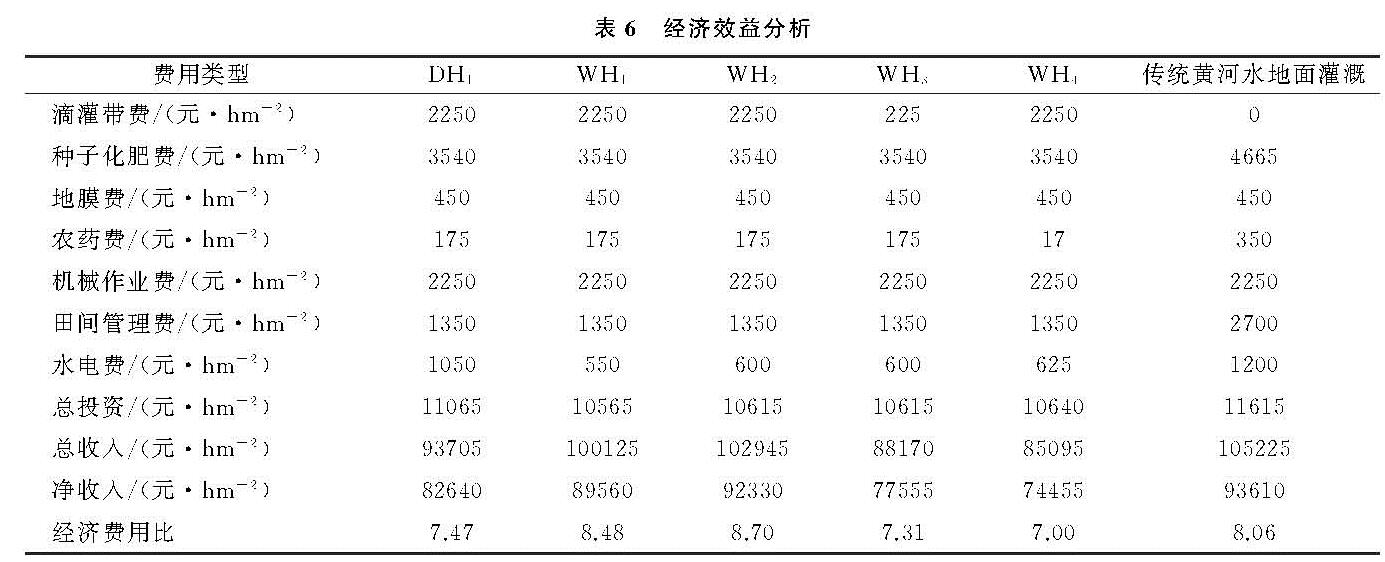2.1 番茄膜下滴灌灌溉结果
单次浅层地下微咸水灌水定额不同,直接导致番茄根区土壤达到设定基质势(-25 kPa)的频率不同,因此由张力计指导的灌溉定额产生差异,2018年番茄膜下滴灌灌溉结果见表3。从表3中可以看出,淡水灌溉处理的灌溉定额最小为240 mm,微咸水灌溉的灌溉定额均不小于280 mm,且灌水定额越大,番茄全生育期灌水总量越大。相对于DH1处理,WH1处理全生育期灌水量增加16.67%,这可能是由于番茄幼苗期需水量大,而微咸水相比淡水含有更多盐分,相同灌水定额下,微咸水处理的土壤基质势变化频率更高,张力计更容易达到试验设定的目标值-25 kPa,由此指导的灌溉频率增大。番茄各生育期中,幼苗期相对其他生育期灌水量最大(120~150 mm),这是因为番茄幼苗期历时最长,幼苗期试验田蒸发蒸腾作用相对其他生育期更强烈,番茄植株需水量更大。各微咸水灌溉处理在番茄生育期内的灌水总量相差较大,随着地下微咸水单次灌水定额从20 mm增加至50 mm,全生育期灌溉次数减少但灌溉定额增加。
2.2 微咸水膜下滴灌对番茄生长和产量的影响
2.2.1 微咸水灌水定额对番茄成活率的影响
由于番茄耐盐性较弱[20-21],地下微咸水中含有盐分离子,不合理的灌溉制度会增加番茄幼苗根区土壤盐分浓度,对幼苗产生盐分胁迫,影响移栽的幼苗成活率。番茄幼苗在5月14日的移栽密度为44 444株/ hm2,试验田移栽的番茄幼苗在移栽1~2周后的成活率见图3。番茄移栽一周后,各试验处理的幼苗成活率差异不显著,约为96%。但番茄移栽两周后,微咸水灌溉处理的幼苗成活率相对于淡水灌溉处理显著降低约6.38%~19.15%,且随着灌水定额的增大,番茄幼苗成活率降低。这可能是由于番茄栽培育苗的环境条件适宜,而自然环境的土壤水热盐等环境相对设施栽培育苗更恶劣,幼苗难以适应,不合理的灌溉模式将导致部分番茄幼苗死亡[22]。番茄幼苗移栽1~2周,WH3和WH4处理的成活率显著降低,这可能是由于番茄在幼苗阶段对土壤盐分环境敏感,第一次灌水后,WH3和WH4处理单次灌水定额大,向表层土壤带入更多的盐分,番茄已在一周以后开始对番茄幼苗产生胁迫,导致部分幼苗脱水死亡。另外WH1和WH2处理番茄成活率差异不显著,类似地,WH3和WH4处理番茄成活率无显著差异,但WH3和WH4处理相对于WH1和WH2处理成活率显著降低约11.49%。因此,为了保证番茄种植高产,需要在番茄苗期采用淡水灌溉等措施确保较高的番茄幼苗成活率。
2.2.2 微咸水灌水定额对番茄株高和茎粗的影响
株高和茎粗是衡量番茄植株生长状况的重要形态指标,番茄植株的高矮和粗细状况直接影响了番茄的光能利用。据相关研究,番茄植株在花期株高和茎粗达到生育期内最大值[23-24],分析试验阶段各处理番茄植株在花期末(7月1日)的生长指标,结果见图4。由图4A可知,相同灌水定额(20 mm)下,微咸水灌溉处理的株高小于淡水处理; 微咸水灌溉处理下,随着单次灌水定额的增大,番茄株高先增大后减小,WH3处理株高最大。这说明相同灌水定额条件下,淡水相对于微咸水更有利于番茄植株增高,微咸水灌溉条件下,单次灌水定额对番茄的株高影响显著,且当单次灌水定额达到40 mm时,番茄株高最大。由图4B可知,相同灌水定额下,微咸水处理的茎粗小于淡水灌溉处理; 相同微咸水处理下,随着单次灌水定额的增大,番茄茎粗随之增大,这说明微咸水灌溉有利于番茄茎粗的增长,可能是试验区浅层地下水中的部分离子促进植株茎粗的增长。该试验结果与翟红梅等[23]研究结果不一致,翟红梅等利用矿化度3.0 g/L微咸水灌溉番茄,结果表明番茄株高、茎粗和叶面积分别下降44.1%,48.0%,55.6%,造成不同的可能原因是翟红梅等种植番茄采用的是基质栽培方式,而本试验是在自然条件下进行的土壤栽培。
2.2.3 微咸水灌水定额对番茄产量和品质的影响
相关研究表明,微咸水相对于淡水一方面向土壤中携带了更多的盐分,对植株根系产生盐分胁迫,不利于根系吸水,另一方面微咸水中的部分盐分离子会对番茄的营养生长和生殖生长产生积极作用[15,25-26]。番茄产量及产量主要构成因素见表4。微咸水膜下滴灌的番茄收获株数相对淡水滴灌处理下降7.5%~20%。淡水灌溉处理的单株果数最少,单果均重最大,微咸水各灌溉处理的单株果数没有显著差异,但单果均重随着单次灌水定额的增加先增大后减小,且当微咸水灌水定额为30 mm时,番茄单果均重达到最大值50.75 g,这说明灌溉水中盐分含量同时影响番茄的单株果数和单果均重,微咸水中可能含有某些微量元素能促进番茄开花坐果,试验区地下矿化度为3.0 g/L左右的微咸水有利于提高果实缔结率,另外,浅层地下微咸水在一定灌水定额范围内提高番茄果实的物质含量,但其单次灌水定额对番茄单株果数无显著影响。WH2处理番茄产量最高为68 630 kg/hm2,WH1处理和WH2处理相对DH1处理产量分别提高6.85%,9.86%,而WH3处理和WH4处理相对DH1处理产量分别下降5.91%,9.19%。这说明年均矿化度3.0 g/L的地下微咸水在一定灌水定额范围内能增加番茄产量,提高单位面积农田产出。该结果与Karlberg等[27]在南非用滴灌方式进行微咸水和咸水灌溉试验得到的结果一致,他们研究发现适宜灌溉制度下,微咸水和咸水灌溉番茄的产量均高于平均产量。但是,万书勤等[15]研究发现盐分浓度(1.1~4.9 dS/m)和土壤基质势(-50~-10 kPa)对番茄产量影响不显著,这主要是因为万书勤等在番茄缓苗阶段采用淡水灌溉,而本试验在番茄缓苗阶段即采用地下微咸水灌溉,对番茄苗期的成活率影响较大。此外,微咸水灌溉处理的灌溉水分生产率随着单次灌水定额的增大而减小。从提高番茄产量的角度考虑,本文建议试验区浅层地下微咸水的单次灌水定额为30 mm。
可溶性固形物、番茄红素、总糖、总酸是评价番茄口感风味与营养价值的重要指标[19,28-29],通过对膜下滴灌各试验处理的番茄红熟果实进行采样分析,其主要品质指标分析结果见表5。淡水灌溉处理的番茄可溶性固形物、红色素和总糖含量最少,但总酸含量最高,口感风味指标最大。淡水灌溉处理对应番茄果实的可溶性固形物、总糖和口感风味指标与其他微咸水灌溉处理间无显著性差异。浅层地下微咸水灌溉处理对应番茄的可溶性固形物、总糖含量和口感风味指标之间无显著性差异,但可溶性固形物、红色素和总糖含量随着单次灌水定额的增加而增加,总酸含量随单次灌水定额的增加而减小。番茄果实的口感风味指标随着微咸水灌水定额的增大先增加后减小,当试验条件下微咸水单次灌水定额达到30 mm时,番茄口感风味最佳。这可能是由于微咸水中含一些微量元素有利于可溶性固性物、番茄红色素和总糖的形成。以上研究结果与Abdel-Gawad等[13]研究咸水灌溉得到的结果相符合,Abdel-Gawad等认为一定量的咸水灌溉可提高番茄的可溶性固形物含量。由以上分析可知,适当提高微咸水灌水定额可以改善番茄果实的品质。
2.3 微咸水灌水定额对土壤盐分累积规律的影响
微咸水相比淡水含有更高的盐分含量,在滴灌过程中,灌溉水既携带了盐分进入膜内表层土壤,又增加了表层土壤水分含量,稀释了表层土壤溶液的盐分浓度,随着灌溉水入渗形成湿润峰,膜内土壤中盐分随湿润峰运移至膜外和膜内深层土壤。对番茄整个生育期内的盐分积累情况进行的定量分析结果见图5。番茄生育期内膜下滴灌各试验处理在0—100 cm土体均积盐,淡水灌溉处理各层土壤积盐量均小于微咸水灌溉处理,在表层30 cm土体内,各试验处理膜内积盐量均小于膜外; 微咸水灌溉处理的膜内0—80 cm土壤积盐量随着灌水定额增加先减小后增加,且当微咸水灌水定额达到30 mm时,膜内0—80 cm土壤积盐量最少,这说明,微咸水灌溉不仅能淋洗表层土壤盐分,还会携带盐分进入农田,当微咸水单次灌水定额小于30 mm时,微咸水灌溉对土壤盐分的淋洗作用大于灌溉水本身携带盐分的影响,当微咸水单次灌水定额大于30 mm时,微咸水灌溉对土壤盐分的淋洗作用小于灌溉水本身携带盐分的影响。另外,膜外0—60 cm土壤积盐量随着灌水定额的增加而增大,这主要是由于膜内表层土壤盐分随着湿润峰向膜外迁移,膜外底层土壤盐分因表土蒸发随水分向地表迁移,均在膜外地表积聚。相对于表层土壤,膜内、膜外80—100 cm土壤盐分变化较迟缓。由于淡水滴灌和微咸水滴灌均会造成0—100 cm土体积盐,为了防止土壤次生盐碱化,需要在番茄非生育期引入黄河水补充灌溉,以淋洗土壤盐分,维持农田土壤盐分平衡。为了减少微咸水灌溉下番茄生育期内0—100 cm土体积盐,本文建议试验区浅层地下微咸水的单次灌水定额为30 mm。
本研究监测时间较短,在后续研究中应该考虑不同的土壤基质势控制水平,综合分析试验区浅层地下水的矿化度变化规律,设计不同轮灌/混灌制度,对各层土壤盐分进行长系列监测,探究土壤盐分与地下水位动态变化的响应关系,为合理调控地下水位、科学制定区域“井渠结合”制度提供更加充实的理论基础。
2.4 番茄微咸水膜下滴灌经济效益
由于河套灌区目前主要采用传统黄河水地面灌溉方式种植番茄,本文引入传统黄河水地面灌溉方式与本试验各处理进行经济效益对比分析,结果见表6。相对于传统黄河水地面灌溉,膜下滴灌的单位面积总投资均减小,而且,微咸水膜下滴灌的单位面积总投资小于淡水滴灌,这主要是因为试验取用的淡水来自储存的渠引黄河水,结合淡水膜下滴灌定额得到引黄河水的水资源费为600元/ hm2。净效益分析结果表明,传统黄河水地面灌溉的单位面积净收入最高为93 610元/hm2,其次为WH2处理,WH4处理净收入最低; 相对传统黄河水地面灌溉,淡水滴灌处理净收益减少11.72%。微咸水滴灌处理对应净收益随着单次灌水定额的增加先增加后减小,且当灌水定额为30 mm时,净收益达到最大值,WH2处理相对淡水滴灌处理净收益增加11.73%,但相对于传统黄河水地面灌溉净收益降低1.37%。WH2处理对应的经济费用比最高为8.48,相对于淡水滴灌和传统黄河水地面灌溉分别提高14.14%,7.36%。
从净收益结果来看,延用传统黄河水地面灌溉最佳,但WH2处理相对黄河水地面灌溉的净收入仅减少不足2%,略次于传统灌溉模式。导致微咸水灌溉模式净收入小于传统黄河水地面灌溉模式的主要原因是番茄幼苗移栽后,在幼苗期即采用微咸水灌溉显著降低了番茄幼苗成活率(不足移栽密度的90%),而传统黄河水地面灌溉模糊在移栽后及时采用淡水(黄河水)进行地面灌溉,番茄幼苗成活率约占移栽密度的95%,若能在番茄苗期采取诸如淡水灌溉等适当措施提高番茄幼苗的成活率,生育后期采用微咸水灌溉(灌水定额为30 mm),将显著提高单位面积农田番茄产量和净效益。另外,采用膜下滴灌模式可以考虑适当增加番茄种植密度,从而增加番茄产量。因此,制定合理的灌溉制度和实施科学的种植模式及农艺措施,微咸水膜下滴灌番茄对应的净效益可以超过传统黄河水地面灌溉模式。











